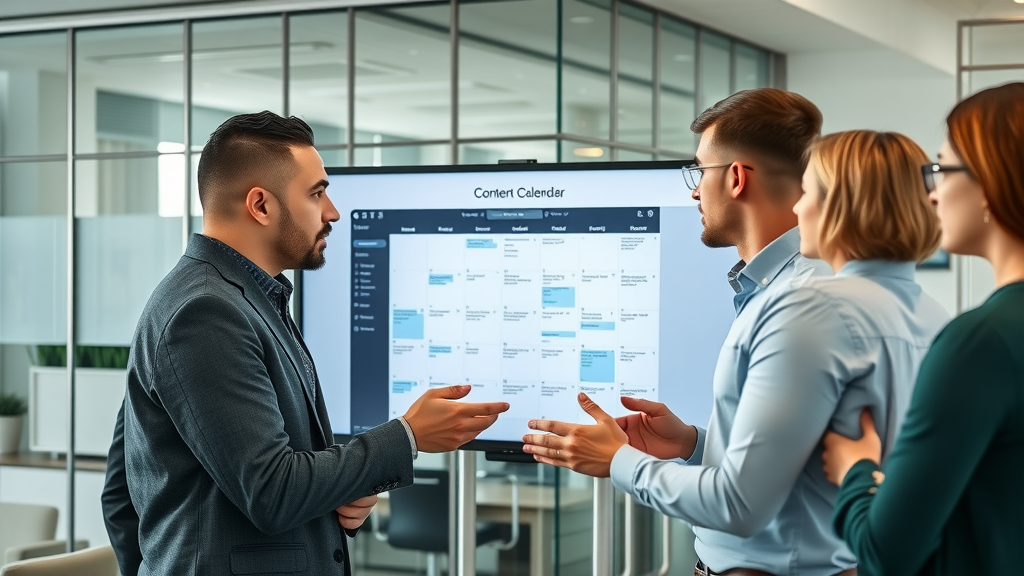Did you know: More than 70% of marketers are actively investing in content marketing, but only those with a well-planned digital content strategy see measurable results. In today’s fast-paced online landscape, an ad-hoc approach won’t cut it. Your competitors are doubling down on digital content strategy—and if you want to stand out, so should you. This comprehensive guide will show you not only why a robust digital content strategy matters, but also the exact steps to create, execute, and maximize it. Whether you’re a business owner, marketer, or entrepreneur, this is your blueprint to rapid online growth and awareness.
How a Digital Content Strategy Can Transform Your Online Presence
A digital content strategy is no longer a luxury—it’s an essential driver for business success. From increasing brand awareness to converting potential customers into loyal advocates, a detailed strategy integrates your company’s goals with the needs and interests of your target audience. When you invest in a focused approach, each piece of content—whether a blog post, video, social media update, or infographic—works together to move your brand forward.
Consider how competitors leverage content marketing for rapid growth: they deploy tailored content types across multiple digital channels, measure user experience, and continuously optimize based on real data. With a robust content plan supporting your business goals, your digital presence evolves from scattered to strategic. The end result? A recognizable brand, increased online authority, and measurable business results that outpace those who simply “post and hope.”

-
What You'll Learn:
- Why a robust digital content strategy is essential for business success
- The key components of an effective content strategy
- How to craft content plans for maximum impact
- Actionable steps and tools to launch your digital content strategy quickly
"More than 70% of marketers are actively investing in content marketing, but only those with a well-planned digital content strategy see measurable results."
Understanding Digital Content Strategy: Core Elements for Success
Defining Digital Content Strategy for Modern Marketers
In simple terms, a digital content strategy is a comprehensive roadmap that outlines how organizations use various digital content—such as blog posts, videos, podcasts, and social media updates—to reach specific business goals. Unlike generic content creation, every element in your strategy ties back to what your company wants to achieve, from generating leads and boosting brand awareness to improving user experience across digital channels.
For modern marketers, developing an effective content strategy means considering multiple factors: What are your business goals? Who is your target audience? Which channels and content types will resonate most? The answers to these questions help you craft a clear pathway for consistent online growth, instead of leaving your digital fate to chance.
How Content Strategy Differs from Content Marketing and Marketing Strategy
Content strategy , content marketing , and marketing strategy often get used interchangeably, but they serve distinct functions. Content strategy is the overarching plan for developing, managing, and delivering meaningful digital content. Content marketing, meanwhile, is the execution—publishing content to attract, engage, and convert your audience. Marketing strategy is broader still, encompassing everything from advertising and PR to digital campaigns and customer outreach.
Think of a digital content strategy as the blueprint for your content operations, ensuring every blog post, video, or infographic serves a specific business purpose. Without strategy, even the most creative campaigns risk falling flat. Integrating all three—strategy, marketing, and overall business plans—ensures your investment in digital channels yields a real return.
Aligning Business Goals and Target Audience Within Your Content Strategy
A winning digital content strategy always starts by connecting your business goals to your target audience . This means identifying what you want to achieve—greater brand awareness, increased web traffic, more sales—and understanding who your customers are (their interests, challenges, and where they spend time online).
The most successful brands create detailed buyer personas, tailor messages and content types for each segment, and map every piece of content to distinct stages of the customer journey. As a result, your digital content doesn’t just reach people; it resonates, informs, and motivates them to act—paving the way for higher engagement, loyalty, and ROI.

Building Blocks of an Effective Digital Content Strategy
Identifying and Analyzing Your Target Audience
A strong digital content strategy begins by truly understanding your target audience . It’s not just demographics—age or location—but delving deeper into their motivations, challenges, and online behaviors. Through audience research (using analytics, surveys, and buyer persona development), you can pinpoint exactly where your potential customers congregate online and what content types engage them most.
This clarity guides everything that follows—content creation, distribution channels, and even your content calendar. For example, a B2B brand might find their target audience values in-depth whitepapers on LinkedIn, while a consumer retail brand’s buyers flock to social media and Instagram Stories. The sharper your audience insights, the more effective your strategy becomes.
Setting Measurable Business Goals for Digital Content
Every effective content strategy starts with clear, measurable business goals . What are you aiming to achieve? Is it to increase brand awareness, drive website traffic, generate more leads, or improve the overall customer experience? Creating SMART (Specific, Measurable, Achievable, Relevant, Timely) goals ensures your efforts are focused—and that you can prove ROI later on.
For instance, an e-commerce business may set a goal to increase blog-driven sales by 25% over six months, while a B2B firm might aim for a 10% increase in LinkedIn engagement. These goals shape your content plan, inform which metrics to track, and help align your entire team around a unified vision for success.

Conducting a Content Audit: Evaluate Your Existing Content
To get the most out of your digital content strategy, start with a content audit. This means inventorying all your existing content —blog posts, videos, landing pages, and social updates—to evaluate what’s performing well, what needs updating, and what should be retired altogether. Use tools like Google Analytics, SEMrush, and Ahrefs to identify which topics and formats drive the most engagement and align with your business goals.
A strategic content audit reveals gaps and opportunities. You might find outdated information, duplicate content types, or high-performing pieces you can repurpose across different digital channels. With this foundation, your future content plan supports both quick wins and sustainable, long-term growth.
Choosing the Right Content Types for Maximum Engagement
Not all types of content are created equal—and the best digital content strategies select formats that resonate with the intended audience. This might include in-depth blog posts for thought leadership, engaging videos for social media, informative infographics, or even interactive quizzes and downloadable guides.
Analyze where your audience consumes information and match your content types to those preferences. If your target customers are professionals, LinkedIn articles or webinars could be key. If they’re younger and mobile-savvy, try Instagram Reels, TikTok videos, or visual Pinterest boards. Mixing content types keeps your audience engaged and increases the reach of your overall content plan.
Establishing a Content Calendar and Content Plan
A content calendar is the backbone of an organized digital content strategy . It outlines what content will be published, when, on which digital channels, and for which target audience. This proactive scheduling prevents content gaps, batch-creates resources for recurring campaigns, and ensures consistent messaging across your brand platforms.
Start by mapping topics to your business goals and key dates (product launches, holidays, industry milestones), then select the most relevant content types for each. A good content plan anticipates shifts in audience behavior, making it easier to adjust as trends and analytics evolve—keeping your strategy nimble and results-driven.
Executing Digital Content Strategy: From Planning to Publication

Developing Effective Content Operations for Smooth Workflow
Strong content operations are the difference between a strategy that stays on paper and one that drives revenue. Operations encompass the workflow, people, and technologies that turn ideas into published content. Effective processes include clear editorial guidelines, well-defined roles (writers, editors, designers, strategists), and a streamlined approval path.
Operational efficiency allows for scalable content creation and quick adaptation to feedback or changing business goals. Tools like project management software, editorial calendars, and automated reminders keep your content plan on track, prevent costly bottlenecks, and support both creativity and consistency.
Selecting the Best Content Management System for Your Needs
A modern content management system (CMS) is central to executing your digital content strategy. Whether you choose a traditional CMS like WordPress, a headless CMS for flexibility, or an enterprise platform, your CMS should match your content types, publishing volume, and digital channel integration needs.
Evaluate each solution against your business goals: Does it support multi-channel distribution? Can it facilitate mobile app or website content? Is it intuitive for your team to use? Investing in the right CMS streamlines your operations, improves user experience, and helps you respond faster to shifting digital landscapes.

Optimizing Content for User Experience and Customer Experience
Great content is more than the sum of words or visuals—it creates a strong user experience and boosts customer experience . Focus on accessible formats, mobile-friendly layouts, and clear calls to action within each piece of content. Use search engine optimization (SEO) practices to ensure your content is easily found through organic search.
Personalization also matters: leverage data to deliver content recommendations or dynamic landing pages matched to your visitor’s profile. Enhanced user experience leads to longer site visits, higher conversion rates, and greater loyalty, all funneling back to the success of your digital content strategy.
Integrating Social Media into Your Digital Content Strategy
Social media is a powerhouse for content amplification. Publish, promote, and repurpose your best content across channels such as LinkedIn, Twitter, Instagram, and Facebook, tailoring each post for the platform and audience segment. Use analytics to measure engagement and adapt quickly.
Leverage social media to spark conversations, share success stories, and drive real-time feedback. A strong social integration in your digital content strategy ensures your content reaches farther, faster while supporting SEO, community building, and measurable growth in brand awareness.
Content Strategies that Drive Results: Case Studies and Examples

Innovative Content Strategies from Leading Brands
Some of the world’s top companies—think Red Bull, HubSpot, and Nike—deploy digital content strategies that are both creative and data-driven. Red Bull, for instance, became synonymous with adventure by focusing almost exclusively on visually stunning videos and events that resonate with its target audience. HubSpot transformed into an industry leader by publishing free, value-packed blog posts, eBooks, and webinars tailored to every stage of the buyer’s journey.
These brands succeed by consistently matching their content types with audience needs, fueling brand awareness and loyalty. They leverage robust content calendars, measure every campaign’s performance, and adapt their strategies quickly for maximum impact.
How Content Marketing Boosts Brand Awareness
Content marketing is central to increasing brand awareness . Providing helpful, shareable content positions your business as an industry authority and grows organic visibility. For example, a single well-optimized blog post or viral social video can reach thousands, while paid digital campaigns expand reach even further.
The key is consistent, valuable content on the right digital channels, matched to your business goals and target audience preferences. When audiences recognize your brand as a helpful resource, they’re far more likely to engage, share, and ultimately become loyal customers.
Mapping Content Types to Each Stage of the Marketing Funnel
An advanced digital content strategy maps different content types to each stage of the marketing funnel: Awareness, Consideration, and Decision. At the top, use how-to blog posts, explainer videos, and infographics to generate awareness. In the middle, offer in-depth guides, webinars, or case studies to help audiences evaluate options. At the bottom, conversion-focused landing pages, customer testimonials, or product demos seal the deal.
Delivering the right piece of content at the right moment maximizes relevance and moves audiences from initial interest to enthusiastic brand advocates—making your investment in content strategy truly pay off.
Sample Content Calendar Template for Digital Content Strategy| Week | Content Type | Topic | Target Audience | Distribution Channel |
|---|---|---|---|---|
| 1 | Blog Post | Digital Content Strategy Basics | Marketers | Company Blog |
| 2 | Video | How to Audit Existing Content | Content Managers | YouTube, LinkedIn |
| 3 | Infographic | Types of Content Strategies | Business Owners | Instagram, Twitter |
Digital Content Strategy Frameworks: Models to Guide Your Process
Step-by-Step Digital Content Strategy Framework Explained
Crafting a winning digital content strategy involves specific, repeatable steps. Begin with a content audit of your existing content and performance. Next, define measurable business goals and build detailed target audience personas. Map out the types of content that align with each goal, and develop a content calendar to ensure consistent distribution across the right digital channels.
Finally, implement your plan through robust content operations and the right technology stack, including an effective content management system. Review analytics regularly to refine your strategy, ensuring each campaign moves the needle on business success.

Choosing the Right Content Management System and Tools
With countless options on the market, selecting the right content management system (CMS) and supporting tools is a make-or-break decision. For most brands, intuitive CMS platforms like WordPress, HubSpot, or a headless CMS offer user-friendliness plus powerful features for multichannel publishing. Supplement your CMS with project management apps, analytics suites, and automation tools to maximize efficiency and insight.
Your technology stack should adjust as your needs evolve; what starts as a simple blog may eventually support complex video campaigns, downloadable resources, or even a mobile app. Stay vigilant in assessing your technology and upgrade whenever needed to keep your content operations running smoothly.
Metrics to Measure Content Strategy Success
It’s not enough to publish—you must measure results. Key performance indicators (KPIs) for digital content strategy include website traffic, conversion rates, social media engagement, lead generation, and customer retention. Monitor these metrics regularly against your initial business goals and adapt your approach where necessary.
Data-driven decisions help optimize future campaigns, validate your content plan, and justify ongoing investment. Ultimately, the most successful strategies are those that not only create but constantly learn and refine for maximum impact.
"Behind every successful digital content strategy is a unified team and a data-driven approach."
Maximizing Brand Awareness and Customer Experience through Digital Content

Creating Seamless Content Operations
Well-oiled content operations mean every step, from brainstorming to publishing content, flows without friction. Assign clear responsibilities, use agile workflows, and plan regular reviews so you catch potential roadblocks before they impact deadlines. Automation tools help with scheduling, collaboration, and approval processes, ensuring consistent delivery—even as your team scales.
Seamless operations free up creative time, empower your team, and deliver a better overall experience to your target audience—establishing your business as a reliable, trustworthy source of value-driven content.
Leveraging Content Marketing for Enhanced Brand Awareness
Content marketing isn't just about volume—it’s about visibility and resonance. Increase brand awareness by tailoring stories and value-packed insights to your audience. Use a mix of content types (blog posts, videos, podcasts, emails), distribute them on the best digital channels, and encourage social sharing to multiply your reach.
Track engagement and feedback closely, iterate on what performs best, and align future content creation with your loyal followers’ preferences. Over time, your reputation grows, and new audiences continually rediscover your brand.
Ensuring Consistency Across Platforms
Your digital content strategy should ensure consistency in voice, branding, and messaging—no matter where your audience finds you. Use shared brand guidelines and repeatable templates for each content type. Automated tools and editorial calendars help your team sync campaigns across multiple digital channels, from your website to LinkedIn and beyond.
Consistency is key for trust: when users experience the same value and voice everywhere, they build stronger associations—and are far more likely to interact, buy, and share.
Adapting Your Digital Content Strategy for Changing Marketing Trends
Top Content Types and Channels for 2024
In 2024, successful digital content strategies are prioritizing interactive content (quizzes, polls), short-form videos (TikTok, Instagram Reels), and immersive experiences like webinars or podcasts. Emerging channels—like AI-powered chatbots and voice search—demand new approaches to content creation and distribution.
Staying up to date with digital marketing trends means regularly evaluating your content types and digital channels for relevance and reach. Brands embracing innovation will outperform those relying solely on traditional blog posts or static social updates.
Future-Proofing Your Marketing Strategy
Truly effective content strategies anticipate, not react. Regularly audit existing content for relevance, invest in audience research, and stay agile in your content plan to pivot rapidly for new trends or technologies. Remember: what works today may not capture customer attention next year.
Future-proofing means remaining open to new distribution models, measuring results closely, and ensuring your platforms and workflows can evolve as the digital landscape changes.
Content Personalization and AI in Digital Content
AI and personalization are revolutionizing digital content strategy. Automation enables businesses to deliver dynamic, tailored experiences—individualized email recommendations, custom product suggestions, or real-time support via chatbots—based on user behavior and data.
Implementing AI-driven analytics in your strategy means smarter segmentation, improved user experience, and higher conversion rates. Brands investing early in personalization and intelligent automation will lead the pack in digital content engagement.
-
Lists to Inspire Your Next Campaign:
- 7 essential types of digital marketing strategies (content marketing, social media, SEO, email marketing, influencer marketing, paid ads, video marketing)
- 5 must-have elements for a content plan
- 3 ways to improve user experience with content
People Also Ask
What is content digital strategy?
A content digital strategy is a comprehensive plan that defines how digital content – such as blogs, videos, and social media posts – will support business goals and reach target audiences. It integrates content operations, brand awareness, and customer experience into a cohesive approach for online growth.
What does a digital content strategist do?
A digital content strategist is responsible for developing content plans, managing content operations, analyzing performance, and ensuring the content aligns with business goals and user experience needs. They oversee the end-to-end process, from strategy to execution, using the latest content management systems and digital marketing tactics.
What is the digital content strategy framework?
The digital content strategy framework outlines the step-by-step process to audit existing content, define the target audience, set business goals, choose suitable content types, establish a content calendar, and measure effectiveness using content marketing metrics.
What are the top 7 types of digital marketing strategies?
The top 7 types of digital marketing strategies are content marketing, social media, SEO, email marketing, influencer marketing, paid advertising, and video marketing. Each plays a crucial part in an integrated digital content strategy.
Answers to Common Questions on Digital Content Strategy
- What are the must-have tools for a successful digital content strategy?
- How often should you audit your content operations?
- When should you adjust your content plan?
- What KPIs matter most in content marketing?
- How do you streamline the content production process?
Action Steps to Launch Your Digital Content Strategy Today
Recap: Key Takeaways for High-Impact Content Strategies
Effective digital content strategy relies on understanding your audience, setting measurable business goals, auditing and optimizing your existing content, choosing the right content types and digital channels, and executing with the right tools and workflows. Continuous measurement and agility are key to dominating your market niche.
Next Steps: Implement Your Digital Content Strategy for Maximum ROI
Ready to boost brand awareness and accelerate growth? Start by outlining your goals, auditing current assets, mapping out a content plan, and investing in the right technology stack. Get your team on board and start testing what works best—then adjust, optimize, and scale for even greater results.
Connect with Experts and Access More Leading-Edge Content
Looking to go further? Engage with industry experts, attend webinars, and download the latest guides to stay at the forefront of digital content strategy. The faster you learn, the faster you grow—don’t let your competitors get ahead!
Final Thoughts: Unleashing the Power of Your Digital Content Strategy
Start today: Craft a data-driven digital content strategy that puts your brand in the spotlight, delivers a stellar user experience, and generates lasting business value. Your online impact is just one smart plan away.
 Add Row
Add Row  Add
Add 





Write A Comment